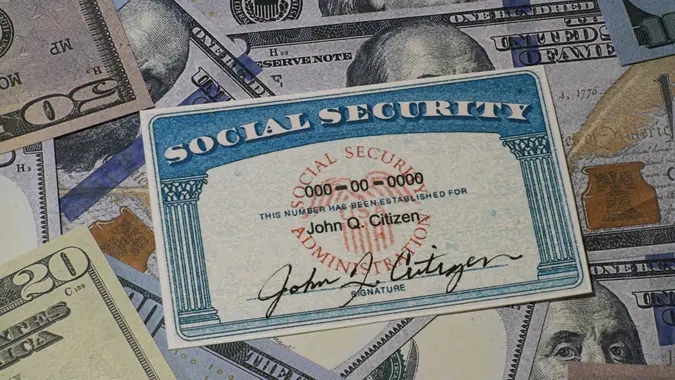Reduce Your Social Security Tax Bill by Following These 4 Tips

Commitment to Our Readers
GOBankingRates' editorial team is committed to bringing you unbiased reviews and information. We use data-driven methodologies to evaluate financial products and services - our reviews and ratings are not influenced by advertisers. You can read more about our editorial guidelines and our products and services review methodology.

20 Years
Helping You Live Richer

Reviewed
by Experts

Trusted by
Millions of Readers
There’s a decent chance that many Social Security recipients will be paying more taxes on their benefits this year than in years past because of a confluence of events, a situation which might convince many of them to take steps to lower their tax bills in the future.
Social Security retirement benefits are taxed based on provisional income and designated income thresholds. The more income you earn, the more you will have to pay in taxes.
Provisional income is determined by adding the combined total of half of your Social Security benefits, your tax-exempt interest, and other non-Social Security items (such as jobs or investments) that make up your adjusted gross income.
According to the Social Security Administration, starting this year, there will be a tax on Social Security benefits similar to private pension income. There will be a phase-out of the lower-income thresholds between 2025 and 2044. Taxation of Old-Age, Survivors, and Disability Insurance (OASDI) benefits will also increase to $50,000 for single filers and $100,000 for joint filers starting in 2026.
How To Lower Your Social Security Tax Liability
What can you do to lower your Social Security tax liability in the future? Here are a few tips to reduce your tax bill where your benefits are concerned.
Start Retirement Planning Early
A good first step is to start planning now if you haven’t yet. Think about the income sources you can expect over the next five to 10 years, and how those sources might impact your provisional income thresholds. Simply put, early retirement planning is the key.
For example, one way to lower your tax bill is to opt for a qualified charitable distribution, or QCD, which lets you give your required minimum distributions to charity. QCDs are excluded from taxable income as is when you donate your required minimum distribution.
Convert Your Retirement Savings to Roth Accounts
Another option is to convert your retirement savings to Roth accounts. Withdrawals from Roth 401(k) plans or IRAs aren’t considered part of provisional income calculations. Before you make a conversion, however, it’s a good idea to consult with a qualified financial planner or tax preparer who can determine how much can be converted without pushing you into a higher tax bracket.
You can also move income-generating assets into a Roth IRA. This way the interest or dividends won’t count immediately as income. You don’t necessarily need to put new money into this account for your plan to work either. You can sell income-producing assets as a tax-advantaged shelter of an IRA.
Be Aware: 8 Common Mistakes Retirees Make With Their Social Security Checks
Minimize Withdrawals From Your Retirement Plans
Think of your withdrawals as income. That’s how they are taxed because anything you pull from a 401(k) or Roth IRA will increase your adjusted gross income. By reducing the amount you withdraw from your account, or not taking any out at all, you get yourself closer to the tax-free threshold.
Tax-Loss Harvesting
While you’re minimizing your withdrawals, you should also make sure to take your maximum capital loss. For example, instead of selling stocks and bonds that you have invested in that have shown a loss, you can claim this loss as a tax deduction, also known as tax-loss harvesting.
This deduction can be substantial and the tax code allows you to write off up to a net $3,000 each year in investment losses. Though any net loss beyond this amount can be carried through to be used in future years, the full value of the net loss could push your Social Security payments into the tax-free area, which can be a good assist for your retirement income.
Social Security for Tax Year 2024
For single tax filers, Social Security beneficiaries aren’t taxed if their provisional income is less than $25,000. That rises to $34,000 if you’re married and filing a joint return. Up to half of your Social Security benefits might be taxable if your provisional income is $25,000 to $34,000 for single filers, or $32,000 to $44,000 for joint filers.
Anything above those income levels, then up to 85% of your benefits could be taxable. Here are a few key takeaways:
- The current Social Security tax rate is 6.2% for employees and 6.2% for employers, for a total of 12.4%.
- The Social Security wage base for the 2024 tax year was $168,600.
- The Social Security taxes are calculated by adding the 6.2% the employee pays to the 6.2% the employer pays for a total Social Security tax rate of 12.4%
- The Social Security and Medicare coverage threshold for household wages in 2024 was $2,700.
- The earnings required for a quarter of coverage in 2024 was $1,730 ($6,920 for four)
Vance Cariaga contributed to the reporting for this article.
More From GOBankingRates
 Written by
Written by  Edited by
Edited by 

























